Kelly Jensen's Blog, page 136
August 27, 2013
Review Roundup: Recent Reads
Because I've gotten a bit behind in writing lengthier reviews, rather than skip out on writing about a few books I've read lately, I thought it'd be worthwhile to write up a few shorter reviews. There's no theme or connection among any of these books except that I read them all around the same time.
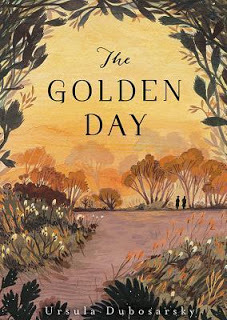
The Golden Day by Ursula Dubosarsky originally published in Australia a couple of years ago, and it's out in the US from Candlewick now. This is a slight novel at under 200 pages, and the primary action of the story happens with the main characters being not-yet teens.
Eleven girls went to the park with their teacher, but eleven girls came back from the park without their teacher. What happened to Miss Renshaw? Did Morgan, a guy who was avoiding the war and lived in the park and with whom Miss Renshaw was wildly smitten, kill her? Or did they run off together into the vast lands of Australia?
Why do the girls share collective silence over what they did or did not see that day in the cave? Why does it take eight years for them to talk about that day together again and share something which they may have constructed entirely for themselves? And is something automatically true if it's been written down? Or do we get to write down what we want the truth to be?
This is a heck of a little book. The story seems quite straight forward, but it's rich with depth, and the writing is strong. The main characters are very young -- late elementary or early middle school -- and the story thus reads through that lens. There is loss of innocence here and it's particularly tough watching that pain happen to the characters as an adult. But I suspect it is precisely at the right level FOR middle grade readers. That's not to say there's not good appeal here for YA readers, but I suspect it might be one of those books advanced middle grade readers would appreciate very much.
The historical setting works -- Australia during the Vietnam War -- and makes sense, even as an American. I was struck especially by what it was Icara hid from her peers -- Cubby especially, who she saw as a "friend" -- because it really felt perfectly in the time period and perfectly what someone her age would do.
I keep thinking, too, about what Miss Renshaw said to Icara. She was "too practical" and wasn't enough of a dreamer, and her father's career as a judge also made her resented by Renshaw. This was yet another layer upon a complex line of questions, particularly about truth, innocence, and the imagination.
The Golden Day explores the idea of history and the idea of collective memory and experience. There's not a solid answer to this story, nor does there need to be. In fact, part of what makes this book so good is that it leaves more questions than answers. Those are the take aways: what happened and what did we make up? Ultimately, do the answers matter? I think Duborsarsky's novel is one to keep an eye on for potential awards early next year. It's a dark horse that I hope more people pick up and experience.
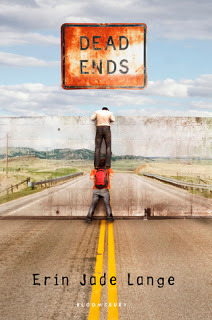
Dead Ends by Erin Jade Lange (available September 3) will feature plenty of spoilers in the review below, so be prepared. This book left me feeling less-than-enthusiastic, and I want to lay out exactly why that is.
Dane's a bully. He has no friends, a long-gone father, and he and his mom are poor. She's an expert at winning the lotto but she doesn't ever cash in the tickets. She frames them on the wall. But her luck might be running out as her job teaching yoga classes continues to be cut back due to low class participation. Worth noting, too, she had him as a teenager and everything since then has been hard times.
Billy is the new kid in town. He just moved in next to Dane, and on the way to school, he follows Dane. Eventually, he makes Dane talk to him. Eventually, he's the reason Dane has another chance at school after yet another fight sends him to the principal's office.
Because Dane has standards -- not hitting girls or people with disabilities -- he's been "kind" to Billy. And that kindness is now an obligation, as the principal declares that in order to keep in school and not be suspended or expelled, Dane has to be Billy's ambassador to his new school. Billy has Down Syndrome, and he fears he might get beat up regularly (a lie, kind of) and Dane can prevent this from happening. Oh, and Dane also has to agree to doing one thing that Billy asks of him.
So what is that one thing?
Dane has to help Billy find his father. The father who disappeared. Who made a "goodbye" gift of a map of strange-named towns scattered throughout the US. Billy wants to help Dane find his dad, too, even though Dane wants nothing to do with finding that man. He'd rather get Billy reconnected with his dad and put it all to bed. Oh also, Billy wants Dane to teach him how to fight, so they practice in the park every week.
Then there's Seely. She's the girl who bumps into them, who wears her hair short and proud, and who is the daughter of two gay men (non-biological daughter -- she had surrogate parents). She wants to help both boys out in her own way.
If you're counting up the issues in this book, you've likely lost track at this point: there's the bully; there's the social class situation; there's the forced companionship between Dane and a boy with Downs Syndrome; there's the romance; there's the two-boys-missing-fathers; there's the boy who wants to find his dad; there's the girl who is herself a story and a half. But wait, there's more! Billy is a LIAR. He makes up stories. He's mislead Dane time and time again about why his parents split. His father was abusive and a hitter and that is why his parents split and his mother moved him away from dad. But don't worry -- there will be misadventures as they seek out this father, and when Billy finally gets in touch with his dad, then he has to move again. Not to mention at the end of the story, Dane finds his dad, too, happy and with another family.
There's too much packed into this novel, and much of the middle sags beneath the idea of the story. For much of the time, I felt like Billy was depicted as very juvenile. He has Down Syndrome, and he's high functioning. The problem was that Dane talked to him and treated him like a child -- and through Dane's "bully" lens, it makes sense. However, this felt so much like a cliche: the bully befriends someone who is Different and therefore becomes a better person because of it. There's very little depth to their relationship, even as it progresses towards the ultimate revelation of what happened to Billy's dad. The depth comes later, when it is revealed that Billy isn't reliable or forthright, and then in that moment, he's suddenly got more depth to both the reader and to Dane. Which is a weird, uncomfortable way for his character to be fleshed out -- I wanted to actually know this boy. I wanted him to be a real person. Instead, he is flat, one-dimensional, and only ever comes to life when it's revealed he's lying. Isn't there more to him?
And maybe it wouldn't have been so frustrating as a reader for that to be the big character development moment if the story wasn't set up in the somewhat cliched ideal that a bad person can be made a better person by being forced to spend time with someone who is "different." Because in this instance, Billy's "differentness" is what makes Dane a better person. It's what forces him to reconsider his bullying tactics and what forces him to reconsider the power of actual, meaningful human relationships (that comes in the form of Seely). Which Seely herself is also flat and underdeveloped.
I get it -- Dane would see these people that way. But it felt like a cheap way to prove a point, by offering up two very Unique characters. They felt shoehorned into a bigger story about bullying that was itself unsatisfying. I wanted Billy to be a full character, rather than a tool. And he is a tool, since the story begins with his first arriving at the school and it ends with him being whisked away -- all within a matter of weeks.
Where Lange wrote an incredible story of bullying in Butter, here that thread gets short shrift to the missing father/social class issues. And it's weird, too, how social class is depicted. Dane is very bitter that he can't have a car like everyone else at school because everyone knows all sixteen year olds get cars (not true in the least, but I buy his hyperbole since he is a 16 year old boy). Poor in Columbia is the trailer park. He is one stop away from there in terms of financial issues at home. And if that is the case, then it makes no sense why his mother is as she is. She works an unsteady job (okay, could buy it, since it's likely her passion) but the lottery tickets she buys, ends up winning, then hangs on the wall rather than cash in? She's SELFISH. It's not a sign of economic struggle; it's a sign of SELFISHNESS. It may be worded as pride, but that pride here evolves into sheer selfishness. In many ways, this is the weakest plot point in the story, and it's what Dane's character and story really hinge on: he bullies because he's jealous. He calls it that eventually, and he owns it -- which I commend -- but I never found myself sympathizing for his situation or WANTING to sympathize, either. Maybe I don't need to, but given how much emphasis he places on social class, it should have actually made a bigger impact than it did. The show of class here was superficial.
In many ways, this felt rushed. It could have been stronger with a few more rounds of editing, with some tougher questions being pursued and explored, and richer characterization of both Dane and Billy beyond their "labels" as bully and boy with a disability who then turns out to be a liar.
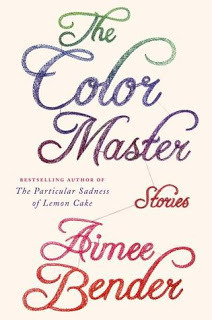
The Color Master by Aimee Bender (available now) was a book I looked forward to for a while because I love Aimee Bender's signature style (The Girl in the Flammable Skirt is in my top ten all-time favorite books).
These short stories are glimpses into worlds so different from our own and yet completely, utterly our own. They are all very sad and very aching. As soon as one ends, it lingers in your chest. These are heavy, meaty stories, even though they feel as though they are not. They are about loss and loneliness, about death and never connecting, never relating to the world and those within it. Of course because these are fairy tales for adults, many -- most -- involve sex and the mythical and mystical power of the act and what it may or may not mean. "On a Saturday Afternoon" perfectly encapsulates this.
Most of the stories in here are excellent, though I felt the lead story "Appleless" was by far the weakest. I was also less impressed with "A State of Variance" (I skimmed the last portion of the story). My favorites were "The Red Ribbon," "Tiger Mending" (perhaps my favorite, with the killer lines Bender is so careful at weaving in that just cut to your core -- "That's the thing with handmade items. They still have the person's mark on them, and when you hold them, you feel less alone. This is why everyone who eats a Whopper leaves a little more depressed than they were when they came in."), "The Color Master" (which depicted feelings -- chest-pounding anger and frustration -- in such an honest way), and "Lemonade."
And this is one of my favorite scenes in one of the stories because it captures precisely what it is what Bender does that makes her work so, so good: "But just beyond his sandwich, and the four TV shows he watched back to back, and his teeth brushing, and his face washing, and his nighttime reading of a magazine, and his light switching off, just the faint realization that there were many ways to live a life and some people were living a life that was very different than his, and the way they lived was beyond him and also didn't interest him and yet he could sense it." -- The Doctor and the Rabbi.
Readers who love magical realism and are okay with heavy sexuality in their short stories will appreciate Bender's collection. I wouldn't necessarily hand it over to a teen reader, though there will be teen readers who appreciate and love The Color Master. It's the kind of book you give to those with a deep appreciation for the way that language works both with a story and on its own separate from the story at hand.






 Related StoriesThe Fallout by S. A. BodeenAudio Review: A Matter of Days by Amber KizerThe Infinite Moment of Us by Lauren Myracle
Related StoriesThe Fallout by S. A. BodeenAudio Review: A Matter of Days by Amber KizerThe Infinite Moment of Us by Lauren Myracle

The Golden Day by Ursula Dubosarsky originally published in Australia a couple of years ago, and it's out in the US from Candlewick now. This is a slight novel at under 200 pages, and the primary action of the story happens with the main characters being not-yet teens.
Eleven girls went to the park with their teacher, but eleven girls came back from the park without their teacher. What happened to Miss Renshaw? Did Morgan, a guy who was avoiding the war and lived in the park and with whom Miss Renshaw was wildly smitten, kill her? Or did they run off together into the vast lands of Australia?
Why do the girls share collective silence over what they did or did not see that day in the cave? Why does it take eight years for them to talk about that day together again and share something which they may have constructed entirely for themselves? And is something automatically true if it's been written down? Or do we get to write down what we want the truth to be?
This is a heck of a little book. The story seems quite straight forward, but it's rich with depth, and the writing is strong. The main characters are very young -- late elementary or early middle school -- and the story thus reads through that lens. There is loss of innocence here and it's particularly tough watching that pain happen to the characters as an adult. But I suspect it is precisely at the right level FOR middle grade readers. That's not to say there's not good appeal here for YA readers, but I suspect it might be one of those books advanced middle grade readers would appreciate very much.
The historical setting works -- Australia during the Vietnam War -- and makes sense, even as an American. I was struck especially by what it was Icara hid from her peers -- Cubby especially, who she saw as a "friend" -- because it really felt perfectly in the time period and perfectly what someone her age would do.
I keep thinking, too, about what Miss Renshaw said to Icara. She was "too practical" and wasn't enough of a dreamer, and her father's career as a judge also made her resented by Renshaw. This was yet another layer upon a complex line of questions, particularly about truth, innocence, and the imagination.
The Golden Day explores the idea of history and the idea of collective memory and experience. There's not a solid answer to this story, nor does there need to be. In fact, part of what makes this book so good is that it leaves more questions than answers. Those are the take aways: what happened and what did we make up? Ultimately, do the answers matter? I think Duborsarsky's novel is one to keep an eye on for potential awards early next year. It's a dark horse that I hope more people pick up and experience.

Dead Ends by Erin Jade Lange (available September 3) will feature plenty of spoilers in the review below, so be prepared. This book left me feeling less-than-enthusiastic, and I want to lay out exactly why that is.
Dane's a bully. He has no friends, a long-gone father, and he and his mom are poor. She's an expert at winning the lotto but she doesn't ever cash in the tickets. She frames them on the wall. But her luck might be running out as her job teaching yoga classes continues to be cut back due to low class participation. Worth noting, too, she had him as a teenager and everything since then has been hard times.
Billy is the new kid in town. He just moved in next to Dane, and on the way to school, he follows Dane. Eventually, he makes Dane talk to him. Eventually, he's the reason Dane has another chance at school after yet another fight sends him to the principal's office.
Because Dane has standards -- not hitting girls or people with disabilities -- he's been "kind" to Billy. And that kindness is now an obligation, as the principal declares that in order to keep in school and not be suspended or expelled, Dane has to be Billy's ambassador to his new school. Billy has Down Syndrome, and he fears he might get beat up regularly (a lie, kind of) and Dane can prevent this from happening. Oh, and Dane also has to agree to doing one thing that Billy asks of him.
So what is that one thing?
Dane has to help Billy find his father. The father who disappeared. Who made a "goodbye" gift of a map of strange-named towns scattered throughout the US. Billy wants to help Dane find his dad, too, even though Dane wants nothing to do with finding that man. He'd rather get Billy reconnected with his dad and put it all to bed. Oh also, Billy wants Dane to teach him how to fight, so they practice in the park every week.
Then there's Seely. She's the girl who bumps into them, who wears her hair short and proud, and who is the daughter of two gay men (non-biological daughter -- she had surrogate parents). She wants to help both boys out in her own way.
If you're counting up the issues in this book, you've likely lost track at this point: there's the bully; there's the social class situation; there's the forced companionship between Dane and a boy with Downs Syndrome; there's the romance; there's the two-boys-missing-fathers; there's the boy who wants to find his dad; there's the girl who is herself a story and a half. But wait, there's more! Billy is a LIAR. He makes up stories. He's mislead Dane time and time again about why his parents split. His father was abusive and a hitter and that is why his parents split and his mother moved him away from dad. But don't worry -- there will be misadventures as they seek out this father, and when Billy finally gets in touch with his dad, then he has to move again. Not to mention at the end of the story, Dane finds his dad, too, happy and with another family.
There's too much packed into this novel, and much of the middle sags beneath the idea of the story. For much of the time, I felt like Billy was depicted as very juvenile. He has Down Syndrome, and he's high functioning. The problem was that Dane talked to him and treated him like a child -- and through Dane's "bully" lens, it makes sense. However, this felt so much like a cliche: the bully befriends someone who is Different and therefore becomes a better person because of it. There's very little depth to their relationship, even as it progresses towards the ultimate revelation of what happened to Billy's dad. The depth comes later, when it is revealed that Billy isn't reliable or forthright, and then in that moment, he's suddenly got more depth to both the reader and to Dane. Which is a weird, uncomfortable way for his character to be fleshed out -- I wanted to actually know this boy. I wanted him to be a real person. Instead, he is flat, one-dimensional, and only ever comes to life when it's revealed he's lying. Isn't there more to him?
And maybe it wouldn't have been so frustrating as a reader for that to be the big character development moment if the story wasn't set up in the somewhat cliched ideal that a bad person can be made a better person by being forced to spend time with someone who is "different." Because in this instance, Billy's "differentness" is what makes Dane a better person. It's what forces him to reconsider his bullying tactics and what forces him to reconsider the power of actual, meaningful human relationships (that comes in the form of Seely). Which Seely herself is also flat and underdeveloped.
I get it -- Dane would see these people that way. But it felt like a cheap way to prove a point, by offering up two very Unique characters. They felt shoehorned into a bigger story about bullying that was itself unsatisfying. I wanted Billy to be a full character, rather than a tool. And he is a tool, since the story begins with his first arriving at the school and it ends with him being whisked away -- all within a matter of weeks.
Where Lange wrote an incredible story of bullying in Butter, here that thread gets short shrift to the missing father/social class issues. And it's weird, too, how social class is depicted. Dane is very bitter that he can't have a car like everyone else at school because everyone knows all sixteen year olds get cars (not true in the least, but I buy his hyperbole since he is a 16 year old boy). Poor in Columbia is the trailer park. He is one stop away from there in terms of financial issues at home. And if that is the case, then it makes no sense why his mother is as she is. She works an unsteady job (okay, could buy it, since it's likely her passion) but the lottery tickets she buys, ends up winning, then hangs on the wall rather than cash in? She's SELFISH. It's not a sign of economic struggle; it's a sign of SELFISHNESS. It may be worded as pride, but that pride here evolves into sheer selfishness. In many ways, this is the weakest plot point in the story, and it's what Dane's character and story really hinge on: he bullies because he's jealous. He calls it that eventually, and he owns it -- which I commend -- but I never found myself sympathizing for his situation or WANTING to sympathize, either. Maybe I don't need to, but given how much emphasis he places on social class, it should have actually made a bigger impact than it did. The show of class here was superficial.
In many ways, this felt rushed. It could have been stronger with a few more rounds of editing, with some tougher questions being pursued and explored, and richer characterization of both Dane and Billy beyond their "labels" as bully and boy with a disability who then turns out to be a liar.

The Color Master by Aimee Bender (available now) was a book I looked forward to for a while because I love Aimee Bender's signature style (The Girl in the Flammable Skirt is in my top ten all-time favorite books).
These short stories are glimpses into worlds so different from our own and yet completely, utterly our own. They are all very sad and very aching. As soon as one ends, it lingers in your chest. These are heavy, meaty stories, even though they feel as though they are not. They are about loss and loneliness, about death and never connecting, never relating to the world and those within it. Of course because these are fairy tales for adults, many -- most -- involve sex and the mythical and mystical power of the act and what it may or may not mean. "On a Saturday Afternoon" perfectly encapsulates this.
Most of the stories in here are excellent, though I felt the lead story "Appleless" was by far the weakest. I was also less impressed with "A State of Variance" (I skimmed the last portion of the story). My favorites were "The Red Ribbon," "Tiger Mending" (perhaps my favorite, with the killer lines Bender is so careful at weaving in that just cut to your core -- "That's the thing with handmade items. They still have the person's mark on them, and when you hold them, you feel less alone. This is why everyone who eats a Whopper leaves a little more depressed than they were when they came in."), "The Color Master" (which depicted feelings -- chest-pounding anger and frustration -- in such an honest way), and "Lemonade."
And this is one of my favorite scenes in one of the stories because it captures precisely what it is what Bender does that makes her work so, so good: "But just beyond his sandwich, and the four TV shows he watched back to back, and his teeth brushing, and his face washing, and his nighttime reading of a magazine, and his light switching off, just the faint realization that there were many ways to live a life and some people were living a life that was very different than his, and the way they lived was beyond him and also didn't interest him and yet he could sense it." -- The Doctor and the Rabbi.
Readers who love magical realism and are okay with heavy sexuality in their short stories will appreciate Bender's collection. I wouldn't necessarily hand it over to a teen reader, though there will be teen readers who appreciate and love The Color Master. It's the kind of book you give to those with a deep appreciation for the way that language works both with a story and on its own separate from the story at hand.







 Related StoriesThe Fallout by S. A. BodeenAudio Review: A Matter of Days by Amber KizerThe Infinite Moment of Us by Lauren Myracle
Related StoriesThe Fallout by S. A. BodeenAudio Review: A Matter of Days by Amber KizerThe Infinite Moment of Us by Lauren Myracle
Published on August 27, 2013 22:00
August 26, 2013
What Goes Around by Courtney Summers -- A Giveaway
Back in January of 2010, I was lucky enough to be part of the judging panel for the Cybils award in YA fiction (which if you are a blogger and want to take part, there are still a few days left to apply). This was my first time ever being on a book-related panel like this, and it was really neat to be a part of a process of working with a handful of other well-read bloggers discussing, debating, and ultimately choosing one book from among seven to be "the best" in terms of literary quality and teen reader appeal as the Cybils winner.
The winner we picked that year was:
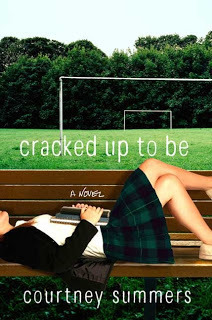
Almost immediately upon finishing it, I ordered Some Girls Are. I then sat on the Cybils reading panel the following year (in the fall of 2010) and after reading a lot of books, Some Girls Are ended up on our short list of titles, too.
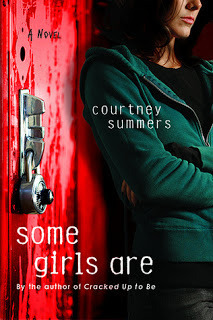
I've since been a huge fan of everything Courtney's written because her characters are honest. They're not made to be pretty or to be friendly and appealing to anyone in the story nor to readers. They're sometimes harsh, sometimes brutal, and always complex. The stories are sharp and unrelenting, with writing that complements them -- that's one big reason that Cracked Up to Be was a Cybils winner.
If you haven't read her books, perhaps you remember Courtney from one of her guest posts here at STACKED, either as part of our So You Want to Read YA? series, our Horror series, or as our very first Twitterview victim way back in 2010.
St. Martin's Press is publishing a bind-up of Courtney's first two gritty books, Cracked Up to Be and Some Girls Are titled What Goes Around next Tuesday, September 3. This is the perfect opportunity for those who haven't checked out her books yet to get a taste of two of her books in one place.
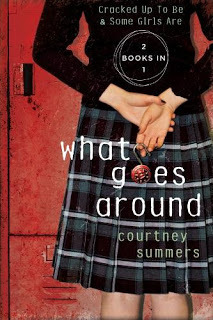
Readers who love Ellen Hopkins's books for their gritty, edgy topics or who love Laurie Halse Anderson for her ability to write raw realistic fiction will find much to appreciate in the two books in What Goes Around.
So what are they about?
Cracked Up to Be is about perfect Parker Fadley falling from the top of the social hierarchy, head cheerleader, do-gooder to being the girl who wants nothing more than to fade out and keep what happened to cause this sudden change in her attitude hidden as much as possible. She feels tremendous guilt and angst over an event she witnessed, but she lets it out in snark and bitterness. Inside, though, she's being eaten alive.
Some Girls Are follows Regina Afton as she, too, falls from being at the top of the social hierarchy, but what causes her downfall isn't what's eating her up inside. It's what she reveals to her best friend that causes her to become cast out and attacked -- but Regina, unlike Parker who retreats inward, takes her pain and hurt externally. It's Mean Girls with actual mean girls.
You can read a 70 page excerpt from What Goes Around right here, which includes a sample of both books.
I think any reader who will find these two stories together for the first time will see a lot of interesting parallels between them, though they are far from the same story. Parker and Regina are very different girls, but the way they each process pain is fascinating to watch (even -- especially -- if it's completely unpleasant).
In honor of the release of What Goes Around, I've got a giveaway. St. Martin's Press has generously offered up two copies of the bind-up for me to pass along to interested readers. It's limited to US and Canadian residents only.
But Wait.
Because I'd love to see more people reading these books and talking about them, I'm also going to give away a set of all of Courtney's books to one reader. The caveat is this: I want this set of four books, which includes Cracked Up to Be, Some Girls Are, Fall for Anything, and This is Not a Test to go to a teacher or a librarian who will get these books into the hands of their teen readers. This can mean putting them in a library or classroom collection OR giving them away as a prize to a teen. All I ask is you use your work email address and click the little box in the form telling me you're a teacher or librarian and are interested in being entered into the giveaway for this set of books.
Ciara, who runs the blog Lost at Midnight, is hosting a read along for new readers and those who have read but want to reread or share a blog post in response to any of these books (I'm cooking up a guest post myself!). You can sign up to take part and read or blog about one of Courtney's books each month this fall. Check it out. You can also find Courtney on Facebook, Twitter, and Tumblr.
Recapping: 2 copies of What Goes Around are up for grabs to anyone in the US or Canada, and one set of all of Courtney's books are up for either a teacher or librarian. Two chances to win for anyone and three chances for those who may be a teacher or librarian. I'll pull winners on or around the second week of September.
Loading...







 Related StoriesTwitterview: Phoebe NorthTwitterview: Karen Healey + Giveaway of When We WakeGiveaways: The Reece Malcolm List & Things I Shouldn't Think
Related StoriesTwitterview: Phoebe NorthTwitterview: Karen Healey + Giveaway of When We WakeGiveaways: The Reece Malcolm List & Things I Shouldn't Think
The winner we picked that year was:

Almost immediately upon finishing it, I ordered Some Girls Are. I then sat on the Cybils reading panel the following year (in the fall of 2010) and after reading a lot of books, Some Girls Are ended up on our short list of titles, too.

I've since been a huge fan of everything Courtney's written because her characters are honest. They're not made to be pretty or to be friendly and appealing to anyone in the story nor to readers. They're sometimes harsh, sometimes brutal, and always complex. The stories are sharp and unrelenting, with writing that complements them -- that's one big reason that Cracked Up to Be was a Cybils winner.
If you haven't read her books, perhaps you remember Courtney from one of her guest posts here at STACKED, either as part of our So You Want to Read YA? series, our Horror series, or as our very first Twitterview victim way back in 2010.
St. Martin's Press is publishing a bind-up of Courtney's first two gritty books, Cracked Up to Be and Some Girls Are titled What Goes Around next Tuesday, September 3. This is the perfect opportunity for those who haven't checked out her books yet to get a taste of two of her books in one place.

Readers who love Ellen Hopkins's books for their gritty, edgy topics or who love Laurie Halse Anderson for her ability to write raw realistic fiction will find much to appreciate in the two books in What Goes Around.
So what are they about?
Cracked Up to Be is about perfect Parker Fadley falling from the top of the social hierarchy, head cheerleader, do-gooder to being the girl who wants nothing more than to fade out and keep what happened to cause this sudden change in her attitude hidden as much as possible. She feels tremendous guilt and angst over an event she witnessed, but she lets it out in snark and bitterness. Inside, though, she's being eaten alive.
Some Girls Are follows Regina Afton as she, too, falls from being at the top of the social hierarchy, but what causes her downfall isn't what's eating her up inside. It's what she reveals to her best friend that causes her to become cast out and attacked -- but Regina, unlike Parker who retreats inward, takes her pain and hurt externally. It's Mean Girls with actual mean girls.
You can read a 70 page excerpt from What Goes Around right here, which includes a sample of both books.
I think any reader who will find these two stories together for the first time will see a lot of interesting parallels between them, though they are far from the same story. Parker and Regina are very different girls, but the way they each process pain is fascinating to watch (even -- especially -- if it's completely unpleasant).
In honor of the release of What Goes Around, I've got a giveaway. St. Martin's Press has generously offered up two copies of the bind-up for me to pass along to interested readers. It's limited to US and Canadian residents only.
But Wait.
Because I'd love to see more people reading these books and talking about them, I'm also going to give away a set of all of Courtney's books to one reader. The caveat is this: I want this set of four books, which includes Cracked Up to Be, Some Girls Are, Fall for Anything, and This is Not a Test to go to a teacher or a librarian who will get these books into the hands of their teen readers. This can mean putting them in a library or classroom collection OR giving them away as a prize to a teen. All I ask is you use your work email address and click the little box in the form telling me you're a teacher or librarian and are interested in being entered into the giveaway for this set of books.
Ciara, who runs the blog Lost at Midnight, is hosting a read along for new readers and those who have read but want to reread or share a blog post in response to any of these books (I'm cooking up a guest post myself!). You can sign up to take part and read or blog about one of Courtney's books each month this fall. Check it out. You can also find Courtney on Facebook, Twitter, and Tumblr.
Recapping: 2 copies of What Goes Around are up for grabs to anyone in the US or Canada, and one set of all of Courtney's books are up for either a teacher or librarian. Two chances to win for anyone and three chances for those who may be a teacher or librarian. I'll pull winners on or around the second week of September.
Loading...







 Related StoriesTwitterview: Phoebe NorthTwitterview: Karen Healey + Giveaway of When We WakeGiveaways: The Reece Malcolm List & Things I Shouldn't Think
Related StoriesTwitterview: Phoebe NorthTwitterview: Karen Healey + Giveaway of When We WakeGiveaways: The Reece Malcolm List & Things I Shouldn't Think
Published on August 26, 2013 22:00
August 25, 2013
Microtrends in YA Fiction
Last fall I did a post about microtrends in YA fiction, which talked about themes or topics that were popping up in a few YA books at the same time, even if the stories weren't necessarily comparable or read alikes to one another. I thought it would be fun to revisit this post again, with a new crop of microtrends I've noticed in YA fiction over the last year.
All descriptions come from WorldCat or Goodreads.
Reality TV
Reality television as the backdrop or premise of a YA novel isn't entirely new. But what's been interesting is that a couple of the books here look at the effects of reality television on the main characters, rather than on the characters being involved with reality television as the story unfolds.
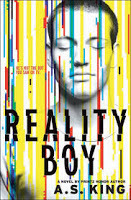
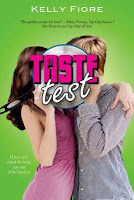
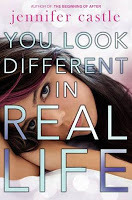
Reality Boy by AS King (out in October): An emotionally damaged seventeen-year-old boy in Pennsylvania who was once an infamous reality television show star, meets a girl from another dysfunctional family, and she helps him out of his angry shell.
Taste Test by Kelly Fiore: While attending a New Hampshire culinary academy, North Carolina high schooler Nora suspects someone of sabotaging the academy's televised cooking competition.
You Look Different in Real Life by Jennifer Castle: Five teens starring in a documentary film series about their ordinary lives must grapple with questions of change and identity under the scrutiny of the camera. (Okay, technically, this is a documentary film series but it plays out like "reality television" would).
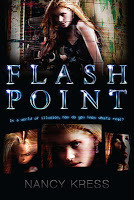
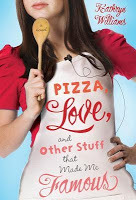
Flash Point by Nancy Kress: Amy had dreams of going to college, until the Collapse destroyed the economy and her future. Now she is desperate for any job that will help support her terminally ill grandmother and rebellious younger sister. When she finds herself in the running for a slot on a new reality TV show, she signs on the dotted line, despite her misgivings. And she's right to have them. TLN's "Who Knows People, Baby--You?" has an irresistible premise: correctly predict what the teenage cast will do in a crisis and win millions. But the network has pulled strings to make it work, using everything from 24/7 hidden cameras to life-threatening technology to flat-out rigging. Worse, every time the ratings slip, TLN ups the ante. Soon Amy is fighting for her life--on and off camera.
Pizza, Love, and Other Stuff that Made Me Famous by Kathryn Williams: Although sixteen-year-old Sophie has grown up working in her family's Mediterranean restaurant in Washington, D.C., she is not prepared to compete on the new reality show, Teen Test Kitchen, when her best friend Alex convinces her to audition.
These aren't the first reality show based YA novels, of course. Older titles, for those who love this storyline in their books, include:
Reality Check by Jen Calonita
L.A. Candy series by Lauren Conrad
The Real Real by Emma McLaughlin and Nicola Kraus
Stir It Up by Ramin Ganeshram
Eat, Pray, Love for Teens
Two books recently were either pitched as -- or further compared to in some capacity -- Elizabeth Gilbert's Eat, Pray, Love. In other words, these are female-led stories where the main character goes on some kind of adventure to find herself. I know that's a pretty generic description, so I get why creating the comparison to Gilbert's book actually says more about the story. But do teens get that reference? I'd be curious about that.
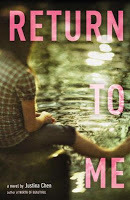

Return to Me by Justina Chen: Always following her parents' wishes and ignoring her psychic inner voice takes eighteen-year-old Rebecca Muir from her beloved cottage and boyfriend on Puget Sound to New York City, where revelations about herself and her family help her find a path to becoming the architect she wants to be.
The Year of Luminous Love by Lurlene McDaniel: Eighteen-year-olds Ciana Beauchamp, Arie Winslow, and Eden McLauren of Tennessee rely on their close friendship as they face serious problems the summer before they start college, from parents' illnesses, to cancer, to two loving the same cowboy.
Physics
When's the last time you read about physics for fun? That's popped up a couple of times in young adult fiction this year. Either the main character likes physics or there's a literary reason behind the use of physics in tying the story together in some way.
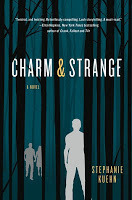

Charm & Strange by Stephanie Kuehn: A lonely teenager exiled to a remote Vermont boarding school in the wake of a family tragedy must either surrender his sanity to the wild wolves inside his mind or learn that surviving means more than not dying.
The Theory of Everything by Kari Luna: When fourteen-year-old Sophie Sophia journeys to New York with a scientific boy genius, a Kerouac-loving bookworm, and a giant shaman panda guide, she discovers more about her visions, string theory, and a father who could be the key to an extraordinary life.
Sticky Fingers
Who knew that kleptomaniacs were so abundant in YA fiction? I think this is an interesting thread running through recent titles, actually, and I think part of my interest is that it's maybe a bit of an under-explored theme in YA fiction in recent years.
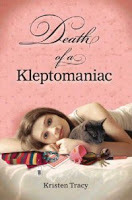
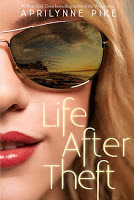
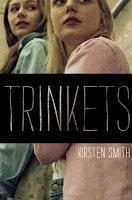
Death of a Kleptomaniac by Kristen Tracy: A sixteen-year-old girl with the uncontrollable urge to steal is trapped in limbo with three days before her funeral to find redemption and true love.
Life After Theft by Aprilynne Pike: Jeff is the new guy in school and the only one who can see Kimberlee, a ghost with a lot of (stolen) baggage. To help her move on, Jeff must return everything she stole when she was alive. But being Kimberlee's accomplice turns into more than he bargained for when his crush and the cops get involved.
Trinkets by Kirsten Smith: When three Lake Oswego High School girls from different social groups, good-girl Elodie, popular Tabitha, and tough Moe, meet in a rehabilitation group, they discover they have much more in common than shoplifting.
Want a few older books featuring teen shoplifters?
Living on Impulse by Cara Haycak
Klepto by Jenny Pollack
Blonde of the Joke by Bennett Madison
Crimes of the Sarahs by Kristen Tracy
Wandering Mothers
I've read many books this year where the mother just sort of disappears. But these books are a little more specific in how they're disappearing. For two of the stories, it's about never wanting to settle and taking the child on the road with them from an early age. For one of the stories, it's about abandoning the family to find herself (which happens later in one of the other stories, too, just when you think mom has figured out how to settle).
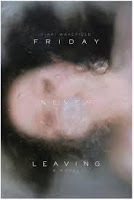
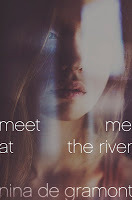
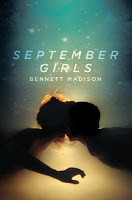
Friday Never Leaving by Vikki Wakefield (September 10): Friday Brown and her mother Vivienne live their lives on the road, but when Vivienne succumbs to cancer, 17-year-old Friday decides to search for the father she never knew. Her journey takes her to a slum of orphans and runaways, ruled by a charismatic leader named Arden.
Meet Me at the River by Nina de Gramont (October 15): Stepsiblings Tressa and Luke, close as children, fell in love as teens, and neither the disapproval of those around them nor even Luke's death can keep them apart as long as Tressa needs him.
September Girls by Bennett Madison: Vacationing in a sleepy beach town for the summer, Sam is pursued by hordes of blonde girls before falling in love with the unusual DeeDee, who compels him to uncover secrets about the community's ocean-dwelling inhabitants.
Emily Dickinson is the new Jane Austen
Where once we couldn't go through a publisher's catalog without stumbling across an homage to Jane Austen (okay, we still can't), now it seems that Emily Dickinson has become a hot commodity in YA fiction.
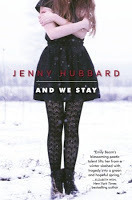
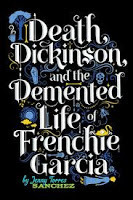
And We Stay by Jenny Hubbard (January 2014): Sent to an Amherst, Massachusetts, boarding school after her ex-boyfriend shoots himself, seventeen-year-old Emily expresses herself through poetry as she relives their relationship, copes with her guilt, and begins to heal.
Death, Dickinson, and the Demented Life of Frenchie Garcia by Jenny Torres Sanchez: Struggling to come to terms with the suicide of her crush, Andy Cooper, Frenchie obsessively retraces each step of their tumultuous final encounter and looks to the poetry of Emily Dickinson for guidance.
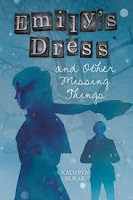
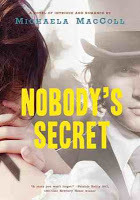
Emily's Dress and Other Missing Things by Kathryn Burak: A new girl in Amherst, Massachusetts, comes to terms with her mother's suicide and her best friend's disappearance with the help of Emily Dickinson's poetry--and her dress.
Nobody's Secret by Michaela MacColl: When fifteen-year-old Emily Dickinson meets a charming, enigmatic young man who playfully refuses to tell her his name, she is intrigued--so when he is found dead in her family's pond in Amherst she is determined to discover his secret, no matter how dangerous it may prove to be.
The Cold War Kids
I've talked extensively about books set in the 80s for no particular reason, but there's a few that have come out or are coming out shortly that are set in the 80s because of one specific reason: the Cold War. The bonus of this setting -- which is, at times also the drawback -- is that it allows the story to be set abroad. It's a bonus since it's always great to have more books set outside the US but it's a drawback because if the historical background isn't complete enough in the book, it can easily distance the reader (remember that today's teens likely don't get much in their history classes beyond World War II, so the context and heft of the time period can be harder to understand).
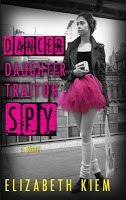
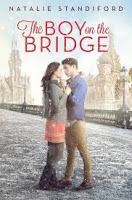
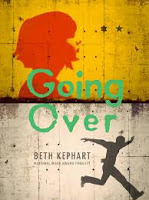
Dancer, Daughter, Traitor, Spy by Elizabeth Kiem: After a harrowing defection to the United States in 1982, Russian teenager Marya and her father settle in Brooklyn, where Marya is drawn into a web of intrigue involving her gift of foresight, her mother's disappearance, and a boy she cannot bring herself to trust.
The Boy on the Bridge by Natalie Standiford: It is 1982 and nineteen-year-old Laura Reid is spending a semester in Leningrad studying Russian, but when she meets Alyosha she discovers the dissident Russia--a world of wild parties, underground books and music, love, and constant danger.
Going Over by Beth Kephart (2014): In the early 1980s Ada and Stefan are young, would-be lovers living on opposite sides of the Berlin Wall--Ada lives with her mother and grandmother and paints graffiti on the Wall, and Stefan lives with his grandmother in the East and dreams of escaping to the West.
The Cold War is a less-explored time frame within YA fiction, but it's not entirely new, either. A couple of older titles include:
Rose Sees Red by Cecil Castellucci
Life: An Exploded Diagram by Mal Peet (at least one of the timelines is during the Cold War)
Have you noticed any other microtrends over the last year? Others I've seen include schizophrenia and obsessive compulsive disorder, as well as books set on islands (which I've written about before but may revisit since it's continued to be a popular setting). Or maybe can you think of other books out in the last 12 months which might fit any of the trends I've listed above?






 Related Stories& Titled: Ampersands in YA FictionThe Fallout by S. A. BodeenAugust Debut YA Books
Related Stories& Titled: Ampersands in YA FictionThe Fallout by S. A. BodeenAugust Debut YA Books
All descriptions come from WorldCat or Goodreads.
Reality TV
Reality television as the backdrop or premise of a YA novel isn't entirely new. But what's been interesting is that a couple of the books here look at the effects of reality television on the main characters, rather than on the characters being involved with reality television as the story unfolds.



Reality Boy by AS King (out in October): An emotionally damaged seventeen-year-old boy in Pennsylvania who was once an infamous reality television show star, meets a girl from another dysfunctional family, and she helps him out of his angry shell.
Taste Test by Kelly Fiore: While attending a New Hampshire culinary academy, North Carolina high schooler Nora suspects someone of sabotaging the academy's televised cooking competition.
You Look Different in Real Life by Jennifer Castle: Five teens starring in a documentary film series about their ordinary lives must grapple with questions of change and identity under the scrutiny of the camera. (Okay, technically, this is a documentary film series but it plays out like "reality television" would).


Flash Point by Nancy Kress: Amy had dreams of going to college, until the Collapse destroyed the economy and her future. Now she is desperate for any job that will help support her terminally ill grandmother and rebellious younger sister. When she finds herself in the running for a slot on a new reality TV show, she signs on the dotted line, despite her misgivings. And she's right to have them. TLN's "Who Knows People, Baby--You?" has an irresistible premise: correctly predict what the teenage cast will do in a crisis and win millions. But the network has pulled strings to make it work, using everything from 24/7 hidden cameras to life-threatening technology to flat-out rigging. Worse, every time the ratings slip, TLN ups the ante. Soon Amy is fighting for her life--on and off camera.
Pizza, Love, and Other Stuff that Made Me Famous by Kathryn Williams: Although sixteen-year-old Sophie has grown up working in her family's Mediterranean restaurant in Washington, D.C., she is not prepared to compete on the new reality show, Teen Test Kitchen, when her best friend Alex convinces her to audition.
These aren't the first reality show based YA novels, of course. Older titles, for those who love this storyline in their books, include:
Reality Check by Jen Calonita
L.A. Candy series by Lauren Conrad
The Real Real by Emma McLaughlin and Nicola Kraus
Stir It Up by Ramin Ganeshram
Eat, Pray, Love for Teens
Two books recently were either pitched as -- or further compared to in some capacity -- Elizabeth Gilbert's Eat, Pray, Love. In other words, these are female-led stories where the main character goes on some kind of adventure to find herself. I know that's a pretty generic description, so I get why creating the comparison to Gilbert's book actually says more about the story. But do teens get that reference? I'd be curious about that.


Return to Me by Justina Chen: Always following her parents' wishes and ignoring her psychic inner voice takes eighteen-year-old Rebecca Muir from her beloved cottage and boyfriend on Puget Sound to New York City, where revelations about herself and her family help her find a path to becoming the architect she wants to be.
The Year of Luminous Love by Lurlene McDaniel: Eighteen-year-olds Ciana Beauchamp, Arie Winslow, and Eden McLauren of Tennessee rely on their close friendship as they face serious problems the summer before they start college, from parents' illnesses, to cancer, to two loving the same cowboy.
Physics
When's the last time you read about physics for fun? That's popped up a couple of times in young adult fiction this year. Either the main character likes physics or there's a literary reason behind the use of physics in tying the story together in some way.


Charm & Strange by Stephanie Kuehn: A lonely teenager exiled to a remote Vermont boarding school in the wake of a family tragedy must either surrender his sanity to the wild wolves inside his mind or learn that surviving means more than not dying.
The Theory of Everything by Kari Luna: When fourteen-year-old Sophie Sophia journeys to New York with a scientific boy genius, a Kerouac-loving bookworm, and a giant shaman panda guide, she discovers more about her visions, string theory, and a father who could be the key to an extraordinary life.
Sticky Fingers
Who knew that kleptomaniacs were so abundant in YA fiction? I think this is an interesting thread running through recent titles, actually, and I think part of my interest is that it's maybe a bit of an under-explored theme in YA fiction in recent years.



Death of a Kleptomaniac by Kristen Tracy: A sixteen-year-old girl with the uncontrollable urge to steal is trapped in limbo with three days before her funeral to find redemption and true love.
Life After Theft by Aprilynne Pike: Jeff is the new guy in school and the only one who can see Kimberlee, a ghost with a lot of (stolen) baggage. To help her move on, Jeff must return everything she stole when she was alive. But being Kimberlee's accomplice turns into more than he bargained for when his crush and the cops get involved.
Trinkets by Kirsten Smith: When three Lake Oswego High School girls from different social groups, good-girl Elodie, popular Tabitha, and tough Moe, meet in a rehabilitation group, they discover they have much more in common than shoplifting.
Want a few older books featuring teen shoplifters?
Living on Impulse by Cara Haycak
Klepto by Jenny Pollack
Blonde of the Joke by Bennett Madison
Crimes of the Sarahs by Kristen Tracy
Wandering Mothers
I've read many books this year where the mother just sort of disappears. But these books are a little more specific in how they're disappearing. For two of the stories, it's about never wanting to settle and taking the child on the road with them from an early age. For one of the stories, it's about abandoning the family to find herself (which happens later in one of the other stories, too, just when you think mom has figured out how to settle).



Friday Never Leaving by Vikki Wakefield (September 10): Friday Brown and her mother Vivienne live their lives on the road, but when Vivienne succumbs to cancer, 17-year-old Friday decides to search for the father she never knew. Her journey takes her to a slum of orphans and runaways, ruled by a charismatic leader named Arden.
Meet Me at the River by Nina de Gramont (October 15): Stepsiblings Tressa and Luke, close as children, fell in love as teens, and neither the disapproval of those around them nor even Luke's death can keep them apart as long as Tressa needs him.
September Girls by Bennett Madison: Vacationing in a sleepy beach town for the summer, Sam is pursued by hordes of blonde girls before falling in love with the unusual DeeDee, who compels him to uncover secrets about the community's ocean-dwelling inhabitants.
Emily Dickinson is the new Jane Austen
Where once we couldn't go through a publisher's catalog without stumbling across an homage to Jane Austen (okay, we still can't), now it seems that Emily Dickinson has become a hot commodity in YA fiction.


And We Stay by Jenny Hubbard (January 2014): Sent to an Amherst, Massachusetts, boarding school after her ex-boyfriend shoots himself, seventeen-year-old Emily expresses herself through poetry as she relives their relationship, copes with her guilt, and begins to heal.
Death, Dickinson, and the Demented Life of Frenchie Garcia by Jenny Torres Sanchez: Struggling to come to terms with the suicide of her crush, Andy Cooper, Frenchie obsessively retraces each step of their tumultuous final encounter and looks to the poetry of Emily Dickinson for guidance.


Emily's Dress and Other Missing Things by Kathryn Burak: A new girl in Amherst, Massachusetts, comes to terms with her mother's suicide and her best friend's disappearance with the help of Emily Dickinson's poetry--and her dress.
Nobody's Secret by Michaela MacColl: When fifteen-year-old Emily Dickinson meets a charming, enigmatic young man who playfully refuses to tell her his name, she is intrigued--so when he is found dead in her family's pond in Amherst she is determined to discover his secret, no matter how dangerous it may prove to be.
The Cold War Kids
I've talked extensively about books set in the 80s for no particular reason, but there's a few that have come out or are coming out shortly that are set in the 80s because of one specific reason: the Cold War. The bonus of this setting -- which is, at times also the drawback -- is that it allows the story to be set abroad. It's a bonus since it's always great to have more books set outside the US but it's a drawback because if the historical background isn't complete enough in the book, it can easily distance the reader (remember that today's teens likely don't get much in their history classes beyond World War II, so the context and heft of the time period can be harder to understand).



Dancer, Daughter, Traitor, Spy by Elizabeth Kiem: After a harrowing defection to the United States in 1982, Russian teenager Marya and her father settle in Brooklyn, where Marya is drawn into a web of intrigue involving her gift of foresight, her mother's disappearance, and a boy she cannot bring herself to trust.
The Boy on the Bridge by Natalie Standiford: It is 1982 and nineteen-year-old Laura Reid is spending a semester in Leningrad studying Russian, but when she meets Alyosha she discovers the dissident Russia--a world of wild parties, underground books and music, love, and constant danger.
Going Over by Beth Kephart (2014): In the early 1980s Ada and Stefan are young, would-be lovers living on opposite sides of the Berlin Wall--Ada lives with her mother and grandmother and paints graffiti on the Wall, and Stefan lives with his grandmother in the East and dreams of escaping to the West.
The Cold War is a less-explored time frame within YA fiction, but it's not entirely new, either. A couple of older titles include:
Rose Sees Red by Cecil Castellucci
Life: An Exploded Diagram by Mal Peet (at least one of the timelines is during the Cold War)
Have you noticed any other microtrends over the last year? Others I've seen include schizophrenia and obsessive compulsive disorder, as well as books set on islands (which I've written about before but may revisit since it's continued to be a popular setting). Or maybe can you think of other books out in the last 12 months which might fit any of the trends I've listed above?







 Related Stories& Titled: Ampersands in YA FictionThe Fallout by S. A. BodeenAugust Debut YA Books
Related Stories& Titled: Ampersands in YA FictionThe Fallout by S. A. BodeenAugust Debut YA Books
Published on August 25, 2013 22:00
August 23, 2013
Links of Note, 8/24/13
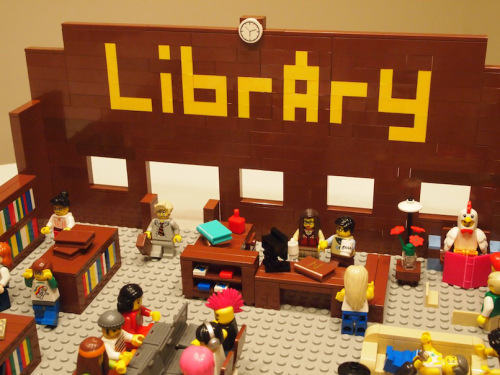
A scene from Mr. Library Dude's second installment of Lego libraries.
Here's your (semi) regular roundup of interesting book-related posts and news from around the web. I'm keeping it short and sweet -- it's been really quiet around the book internet lately.
One of the contributors over at Digital Book World looked at a handful of book recommendation sites and ranked them. It's not as thorough as Leila's amazing recommendation site testing, and it should be noted that the recommender this writer ranked highest was partially developed by a former employer she worked for. But it's still interesting to read.
This job looks awesome -- work for LibraryThing as social media person. You can be located anywhere. It's so tempting.
Rebecca over at Crunchings and Munchings wrote up a nice booklist of "ass-kicking, sporty, competitive" characters in YA fiction. It's a mix of new books and older titles, as well as athletic prowess and ass-kicking in other senses.
In case you missed this piece around the internet, here it is again: I hate Strong Female Characters. I like a lot of the points raised, but I also take issue with a number of them. I see the phrase "strong female character" substituted as an actual description of a character, but I tend to believe -- and use it personally -- to describe when a character has been well-written. It isn't a depiction of their strength but instead of the fact it's actually a full character. I realize that suggests the opposite, that all male characters are therefore strong male characters, but I use it as a means of saying exactly what I mean: the female character is strong in the story.
Sarah Dessen admitted in a recent blog post she did drugs in high school. I liked this response over at Bustle about how it makes her even more relatable to her core readers. I liked more, too, that it didn't raise criticism for her or her work. It made her more real.
A brief history of authors who have graced the cover of Time. Ah, the lack of females persists, but to be fair, there haven't been many authors featured at all.
Ever been curious about Jeff Kinney's (author of Diary of a Wimpy Kid for those of you not already in the know) time management or work style? I hadn't been but then I read this story and thought it was really neat.
How often have cities appeared in different books digitized by Google over the last 200 years? There's a visual for that.
The Life Cycle of a Library Book, brought to you by a Reddit user (it's amusing and fairly accurate).
This week for #readadv, we got to talking about backlist, and Sophie shared this interesting graph about new editions of books that are available from Amazon. Unless the book is very recent or out of copyright and thus new editions can be produced cheaply and easily (think about your new editions of classics), it's likely there aren't new copies available for purchase.
Why do librarians run summer reading clubs? Surely, you read the story about the Evil Librarian and the boy who reads a lot and the mess of pr that's going down there. I have Lots of Thoughts about the situation and how it was handled. I have Lots of Thoughts about summer reading clubs more broadly, but instead, go read Liz's post and see what others have said about the topic.
I'm finally going through some older stuff I have saved in a to-read folder and remembered this awesome post at The Book Smugglers about Open Road Media and their innovative approaches to publishing YA.
The time to nominate stellar librarians doing stellar things in librarianship for the 2014 Movers & Shakers award is now.
At Book Riot, I wrote about the reasons that the internet says are why adults read YA books (and then I'll reveal the real reason, so be prepared).
On a personal note, I'm going to drop this link to a post Liz wrote about the panel she and I proposed for next year's ALA conference. If you'd be kind enough to click over, read what we're hoping to talk about, and then do the quick survey, I'd appreciate it.







 Related Stories"Inside the Industry" Guest Post and Quick SurveyElsewhere in the book worldLinks of Note: August 3, 2013
Related Stories"Inside the Industry" Guest Post and Quick SurveyElsewhere in the book worldLinks of Note: August 3, 2013
Published on August 23, 2013 22:00
August 22, 2013
The Fallout by S. A. Bodeen
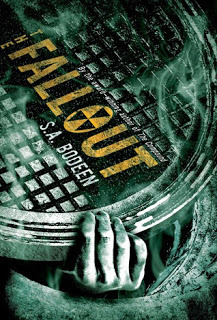
Delayed sequels are interesting, particularly if they're for teens. Presumably, the primary audience for the first book has aged out of the target group for the second. If the first book is still being read widely, though, that's a different story.
It would appear that The Compound belongs to this category. It still circulates fairly well in my public library, and this post on Bodeen's website shows that the teens at my library are not alone. It's still making recommended reading lists as recently as 2012, so librarians and other gatekeepers recognize there's still a teen readership for it as well.
As sequels go, this one is perhaps not "necessary." By that I mean that the plot points of The Compound were all wrapped up fairly well, with no glaring loose ends or cliffhangers. That said, I can certainly see how teens would wonder how Eli and his family recovered from their ordeal. And that story is told in The Fallout . (I love this punny title. It's the best.)
The Fallout is not just about recovery, though that's a good part of it. There's also a conspiracy involving Eli's dad's company, which he is set to inherit, and a very shady businessman who is trying to keep control of the company at all costs. Naturally, this very shady businessman is working with some very shady science - dangerous as well as lucrative, and Eli and his family are involved in his plans.
The story works well as a fast-paced thriller, in much the same way that The Compound did. What this shady businessman has in store for Eli and his family is gradually revealed, and it's horrifying. (Though it's not as horrifying as what Eli's dad had in store in the first book. But then again, what could be as horrifying as that? Nothing.) It's also interesting to see how Eli and his family adjust to living outside of the compound. They're famous for all the wrong reasons, recognizable wherever they go, so a "normal" life is out of the question. They have their own set of stalkers, with websites dedicated to spotting them. They don't know who to trust, and everything is foreign to them - from Costco to a football game.
What doesn't work so well is the development of the relationship between Eli and his twin brother Eddy, whom Eli assumed had died in the first book. What the boys' father did to their family is front-page news. Most of the awful details are very public. Therefore, it's very hard for me to buy Eddy's continued defense of his father. I get that Eddy could resent the return of these family members whom he barely knows (or doesn't know at all, in the case of the youngest siblings). What I don't get is Eddy's envy of Eli for spending so much time with their dad. It's not just a matter of not having the whole story, though there are some bits he's still ignorant of. He knows enough of the truth to know better. I get that Bodeen was trying to instill some tension between the two, and it's necessary for the plot, but it's a weak link.
The science, too, is shaky, but I can forgive this a bit more (I'm being deliberately vague about what science is involved, as it's quite spoilery). I may be ridiculed by hardcore SF fans for saying this, but shaky science doesn't bug me much. If it gets me to wonder "what if," then it's done what I want it to do.
Faults aside, fans of the first will gobble this up. It's intense, twisty, and should be catnip for reluctant readers.
Review copy received by the publisher. The Fallout will be published September 24.







 Related StoriesAudio Review: A Matter of Days by Amber KizerThe Infinite Moment of Us by Lauren MyracleTo Be Perfectly Honest by Sonya Sones
Related StoriesAudio Review: A Matter of Days by Amber KizerThe Infinite Moment of Us by Lauren MyracleTo Be Perfectly Honest by Sonya Sones
Published on August 22, 2013 22:00
August 21, 2013
August Debut YA Books
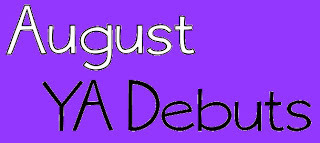
Another month, another roundup of the YA debut novels published or soon to be published. As usual, you can check out the debut novels published in prior months by starting on our July post and working back through to January. We've been a little lax in updating with our review links in those posts, but you can always search our archives if you're curious about any of the titles we may have covered here with more depth.
If I've missed any traditionally published YA debuts out in August, leave a note in the comments. I'm interested only in actual first-time publications, so first YA books by authors who've published in other categories aren't included. All descriptions are from WorldCat or Goodreads.
August is a slower month in publishing, so there are fewer debuts out. But don't worry -- the fall will bring a huge number more.
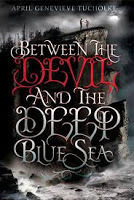
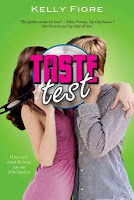

Between the Devil and the Deep Blue Sea by April Genevieve Tucholke: Violet is in love with River, a mysterious seventeen-year-old stranger renting the guest house behind the rotting seaside mansion where Violet lives, but when eerie, grim events begin to happen, Violet recalls her grandmother's frequent warnings about the devil and wonders if River is evil.
Taste Test by Kelly Fiore: While attending a New Hampshire culinary academy, North Carolina high schooler Nora suspects someone of sabotaging the academy's televised cooking competition. This looks like it could be a great read alike for Jennifer E. Smith's books.
On Little Wings by Regina Sirios: Sixteen-year-old Jennifer travels to Smithport, Maine, to learn about the family her mother has kept a secret.
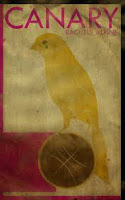
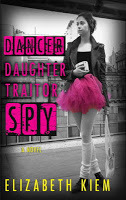

Canary by Rachele Alpine: In this debut novel, a high school girl tries to understand the world, figure out where she fits in, and learn how to stand up for herself when everything falls apart. With the passing of her mother, Kate Franklin's life unravels at the seams as she loses the only emotional mooring in her family. Her dad shuts down completely, and her brother enlists in the army. Things start looking better when her dad is hired to coach at Beacon Prep, home of one of the best basketball teams in the state. In a blog of prose and poetry, Kate chronicles her new world, dating a basketball player, being caught up in a world of idolatry and entitlement, and discovering the perks the inner circle enjoys. Then Kate's fragile life shatters once again when one of her boyfriend's teammates assaults her at a party. Although she knows she should speak out, her dad is vehemently against it and so, like a canary sent into a mine to test toxicity levels and protect miners, Kate alone breathes the poisonous secrets to protect her dad and the team. The once welcoming community has betrayed Kate, her family is disintegrating, and she's on her own to grapple with whether to stay quiet or speak out and expose a town's hero and destroy her father's career.
Dancer, Daughter, Traitor, Spy by Elizabeth Kiem: After a harrowing defection to the United States in 1982, Russian teenager Marya and her father settle in Brooklyn, where Marya is drawn into a web of intrigue involving her gift of foresight, her mother's disappearance, and a boy she cannot bring herself to trust.
If You Could Be Mine by Sara Farizan: In Iran, where homosexuality is punishable by death, seventeen-year-olds Sahar and Nasrin love each other in secret until Nasrin's parents announce their daughter's arranged marriage and Sahar proposes a drastic solution.

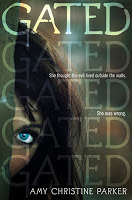
Jumped In by Patrick Flores-Scott: In the two years since his mother left him with his grandparents in Des Moines, Washington, Sam has avoided making friends and perfected the art of being a slacker, but being paired with a frightening new student for a slam poetry unit transforms his life.
Gated by Amy Christine Parker: Seventeen-year-old Lyla feels ambivalent when the charismatic leader of her isolated suburban community is told that the end of the world is near and when it arrives they must all be ready to defend themselves against the unchosen.







 Related StoriesAudio Review: A Matter of Days by Amber Kizer& Titled: Ampersands in YA FictionThe Infinite Moment of Us by Lauren Myracle
Related StoriesAudio Review: A Matter of Days by Amber Kizer& Titled: Ampersands in YA FictionThe Infinite Moment of Us by Lauren Myracle
Published on August 21, 2013 22:00
August 20, 2013
Two Double-Takes
A couple more double-takes for you today:
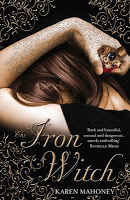
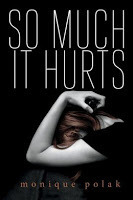
The Iron Witch by Karen Mahoney is a 2011 Flux title. It's an urban fantasy about fairies and alchemy. (It's been on my to-read shelf for a couple years now, too.) I really dig this cover, though that may be partially due to my weakness for sparkles. The markings on the girl's arm are straight from the story, and I love that they extend to the design of the title as well. Plus, she's obviously clutching something relevant too.
So Much it Hurts by Monique Polak is a 2013 Orca title about a girl who becomes romantically involved with an abusive older man. Here, the girl is much paler, and I'm not quite sure if she's holding something in her hand, or if it's been completely edited out. Also interesting to me is that her angle is slightly different - she's a bit more turned down, making her look a bit more like she's suffering or hiding, I think. I prefer the treatment in The Iron Witch, but I don't think this cover is bad, either.
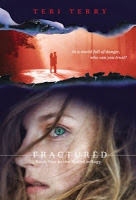
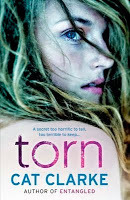
Fractured by Teri Terry is the second in Terry's dystopian trilogy, published by Penguin in 2013. It's also another book that features teens' memories being wiped. The top portion of the cover makes it look pretty SF, I think. I wonder if this is just the ARC cover, since when I "look inside" on Amazon, I get a different (but still pretty generic) cover.
Torn by Cat Clarke is a contemporary realistic book that Kelly really dug about a teenage prank that leads to the death of a girl, and how it affects those involved. The treatment of the photo here is much different: the mirror-image girl looks like she might have just emerged from the pool, her hair soaked with chlorine. Her eyes are a different color, too, and she's washed out. I prefer this cover - it seems to give off an eerier feel, and the girl looks a bit more suspicious since we can see she's looking over her shoulder.






 Related Stories& Titled: Ampersands in YA FictionHardcover to Paperback: Five Changes to Check OutHardcover to Paperback Switches: 6 to Consider
Related Stories& Titled: Ampersands in YA FictionHardcover to Paperback: Five Changes to Check OutHardcover to Paperback Switches: 6 to Consider


The Iron Witch by Karen Mahoney is a 2011 Flux title. It's an urban fantasy about fairies and alchemy. (It's been on my to-read shelf for a couple years now, too.) I really dig this cover, though that may be partially due to my weakness for sparkles. The markings on the girl's arm are straight from the story, and I love that they extend to the design of the title as well. Plus, she's obviously clutching something relevant too.
So Much it Hurts by Monique Polak is a 2013 Orca title about a girl who becomes romantically involved with an abusive older man. Here, the girl is much paler, and I'm not quite sure if she's holding something in her hand, or if it's been completely edited out. Also interesting to me is that her angle is slightly different - she's a bit more turned down, making her look a bit more like she's suffering or hiding, I think. I prefer the treatment in The Iron Witch, but I don't think this cover is bad, either.


Fractured by Teri Terry is the second in Terry's dystopian trilogy, published by Penguin in 2013. It's also another book that features teens' memories being wiped. The top portion of the cover makes it look pretty SF, I think. I wonder if this is just the ARC cover, since when I "look inside" on Amazon, I get a different (but still pretty generic) cover.
Torn by Cat Clarke is a contemporary realistic book that Kelly really dug about a teenage prank that leads to the death of a girl, and how it affects those involved. The treatment of the photo here is much different: the mirror-image girl looks like she might have just emerged from the pool, her hair soaked with chlorine. Her eyes are a different color, too, and she's washed out. I prefer this cover - it seems to give off an eerier feel, and the girl looks a bit more suspicious since we can see she's looking over her shoulder.







 Related Stories& Titled: Ampersands in YA FictionHardcover to Paperback: Five Changes to Check OutHardcover to Paperback Switches: 6 to Consider
Related Stories& Titled: Ampersands in YA FictionHardcover to Paperback: Five Changes to Check OutHardcover to Paperback Switches: 6 to Consider
Published on August 20, 2013 22:00
August 19, 2013
The Infinite Moment of Us by Lauren Myracle
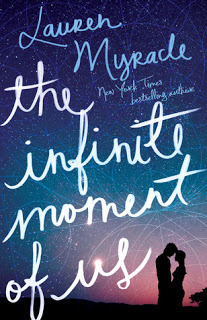
Wren Gray has always lived to please her parents. She's a good girl. She got good grades, she didn't do crazy things while in school, and she's set up on a great path for college and a career thereafter. Everything seems pretty much picture book perfect and there's no question that Wren's privileged in having this.
Except, she's not happy.
This isn't what she really wants.
The Infinite Moment of Us is a story set over the summer between high school and college that follows as Wren chooses to diverge from the path that looked so straight before her. Because Wren isn't happy -- everything up until this moment has been about pleasing her parents and following through with what they expected of her. Rather than go to college, Wren has asked for a deferment and wants instead to spend a year in Guatemala doing volunteer service. She wants to do this not only because it's a cause she's interested in (I'd hesitate to say it's a cause she's passionate about because the truth is Wren doesn't know her passions) and because it'll give her an entire year to sort out what it is she wants from her life. Now that she's 18, out of high school, and able to make her own life choices for herself, Wren is ready to stand up and do just those things.
If she can tell her parents of her plan, that is. Because as of now, they're still thinking she's going to Emory in the fall.
Enter Charlie. He's always been a guy on Wren's mind -- just a little -- but she's never pursued relationships before seriously. She had other things she had to do, and she always had it in the back of her mind that a serious romance would mar the image her parents held of her. He's kind of a mystery, but this summer, Wren finally has the chance to get to know Charlie. He's not what he appears on the outside at all. Sure, he's sweet and charming, but he's got a much deeper personal life than Wren ever expected. He's a foster child, and his brother Dev is disabled. Charlie also has a friend named Starrla who he cares deeply about -- they had been in a relationship before -- and she's regularly needing his time and attention.
Over the course of the summer, Wren and Charlie become very close. Their relationship is one of compassion, care, and intimacy. In fact, it's easiest to maybe suggest this book's theme is that of intimacy: what does it mean to know someone, both in an emotionally raw manner and in a physically raw manner? We know Wren's course of action from the start is she wants a change. She wants to take complete ownership of her life and follow through on things that she wants to do, without regard to what her parents want for her. Charlie fears he's stuck in his situation because of his background. As much as the two of them fall for one another, Wren regularly holds back, and she regularly reassess who she is in relation to Charlie. Can someone with the privilege and future she has before her possibly have a reason to complain to Charlie, who is helping take care of his brother? Who hasn't had a charmed child or teen hood like she has?
This is where Lauren Myracle gets fantastic.
Of course Wren has the right to do this, and Charlie encourages and supports Wren through her deeply internal struggles. Where her "problems" are about wanting to separate her own desires from those her parents have hoisted upon her, Charlie reminds her that her problems aren't silly. That just because his situation is different from hers doesn't mean that her situation isn't problematic or challenging or doesn't merit the sort of time and consideration she's given to it. Where she wants to regularly "rise above" her problems, Charlie reminds her that it's okay not to. That it's okay to feel as she does and that she is, in fact, making changes, even if it doesn't necessarily feel or seem like it to her.
The Infinite Moment of Us deals with female sexuality -- with teen sexuality more broadly -- in a very straight-forward, honest manner. This book doesn't pull punches. Wren and Charlie are intimate, and it doesn't black out on the page. Myracle instead offers readers truth about what happens between two people who engage in sex, and she's forthright in expressing what happens to a female body when arousal happens. But what puts this book squarely in the camp of empowering female sexuality (which I've written in detail about before) is how unashamed Wren is about what happens to her body. It's not gross. It's not embarrassing. It's just what it is -- "Heat spread up her body. Her nipples hardened and her breathing changed, and when she imagined not just his eyes on her, but his hands, his mouth, she grew suddenly, undeniably wet. It embarrassed her, but she didn't want to be embarrassed. Should she be embarrassed? No. She should be . . . She should be excited, which she was, and thrilled and aroused. Her body's response to the boy she loved was a good thing. It was bodies being bodies."
Not only was this reflective of what happens during physical intimacy, but it mirrored precisely what Wren experienced internally about her future, too. It was hers. She could do with it what she wanted. She could be embarrassed about it, or she could react with excitement and thrill and understand she had ownership of it for herself.
As much as there's physical intimacy, there is emotional intimacy as well. That's reflected in how Wren takes the things in her life and considers them, but more so, it's reflected in how she considers her relationship with Charlie. In one moment, when she's feeling the need to talk out her thoughts and problems with him (of course, a moment where she feels she's being silly and that her problems are microscopic and "first world"), Charlie tells her that he is always here for her. She notes that that single line was one of the most intimate things a person can say to another person -- and it's also proof to her that she has the right to feel what it is she does and share it how she needs to.
This book isn't perfect, though. As much as it's powerful in what it portrays in terms of intimacy, sexuality, independence, and the right to pursue one's dreams on one's own, the secondary characters are fairly flat. Wren's best friend is good for sex advice for Charlie (and I loved her for that and I loved Charlie for thinking to talk to Tessa in the first place) but beyond that, she's more prop than full character. More problematic, though, was the Starrla storyline. We know she and Charlie had a challenging relationship and that he still holds her well-being high on his list of cares. But when she tracks him down and pulls out all the stops to regain his attention, I found myself more annoyed than anything. I get that that was the point -- and it's the point Wren walks away with, too, since Starrla is what creates a rift and change in dynamics in her relationship with Charlie -- but I think it needed to be pushed a little further elsewhere in the book to have really made the impact it could have made.
I also took issue with the end of the story. Because it's spoiler, I won't share what happened, but I'll say I felt it was the easy way out of the story for both Charlie and Wren. Many readers will find it satisfying and I totally get that.
By now you've figured out this book deals with sex and is not shy about that. This isn't a book for your younger teens -- unless they're ready for it (and many will be). There is an author's note at the beginning of the book detailing why the choices were made to be forthright in depicting teen sex in the novel, and I think it's as important a read as the book itself. Teens have sex. These two teens in particular have discovered the power and value of intimacy and they are unashamed in expressing and sharing that with one another. This isn't about titillation, though it would be naive to say that teens who read this might not find it to be so -- and you know, I think that's okay. It's presented in a very safe manner, and while the goal from the story perspective certainly isn't about that (and as an adult I can read the story through that lens and not find it sexy at all), it's impossible to project how teens will read it. In other words, it's clear the sex isn't in there to be sexy; it's in there because it's true to Charlie and Wren.
Myracle's book is empowering and feminist. I'd go so far as to say that it's this generation's update of Judy Blume's classic Forever. As I read the book, I couldn't help thinking that this is the kind of book I wish I'd had during my high school years. I would have felt less alone in some of the things I was thinking and feeling, and I know I certainly would have appreciated the honesty with which Myracle portrayed sexuality and what is a completely normal function of a body. Charlie is easy to like, but he's not without flaws. Wren is the same way -- though she may be a little tougher to like from the start than Charlie, she's real and dynamic as a result. Myracle's story is written in third person, distancing readers from the intimacy while managing to bring the intimacy even closer to the reader. This is a fast-paced read and one that will linger.
Pass The Infinite Moment of Us along to readers who want a strong romantic storyline, compelling characters, and who crave emotional rawness to their books. Give it to teen readers who enjoy feminist stories or who are skeptical of how YA authors treat their readers -- Myracle respects them as complex, intellectual people who can make choices for themselves, and there is never a doubt about that in the story.
This is one of my favorite reads this year. And please don't call it "new adult" just because it's set in the summer after high school or deals with sexuality. The Infinite Moment of Us is a YA novel through and through.
Review copy received from the publisher. The Infinite Moment of Us is available August 27.







 Related StoriesAudio Review: A Matter of Days by Amber KizerTo Be Perfectly Honest by Sonya Sones& Titled: Ampersands in YA Fiction
Related StoriesAudio Review: A Matter of Days by Amber KizerTo Be Perfectly Honest by Sonya Sones& Titled: Ampersands in YA Fiction
Published on August 19, 2013 22:00
August 18, 2013
& Titled: Ampersands in YA Fiction
The ampersand is my favorite punctuation mark. I love it because it's so versatile, and I love the history behind the mark (if you look at ampersands from the past, it began as a way to write the Latin word "et," and it eventually moved from being "et" to standing up and looking like it does now as "&").
Over the last few years, more and more YA titles have featured the ampersand. And while I love how it looks aesthetically, it's sometimes hard to search for book titles in a library catalog that feature an ampersand. The search operators can sometimes get caught up on it; often, though, a simple switch to a search by the author's name or using "and" in place of the ampersand can solve the problem.
Because I love ampersands and because I think it's become a trendy title punctuation in the last few years, here's a look at YA titles featuring them. All of these are books published between 2010 and now, with a couple of books that will be out in 2014. I'd love other traditionally published YA titles featuring ampersands, and I'm totally open to older titles. I've limited it to one book per series, as well as one book per author. Also excluded are short story anthologies -- a number of the ones out in the last year or two especially use ampersands.
All descriptions come from WorldCat.
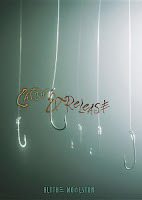
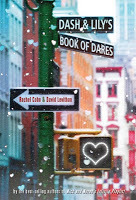

Catch & Release by Blythe Woolston Eighteen-year-old Polly and impulsive, seventeen-year-old Odd survive a deadly outbreak of flesh-eating bacteria, but resulting wounds have destroyed their plans for the future and with little but their unlikely friendship and a shared affection for trout fishing, they set out on a road trip through the West.
Dash & Lily's Book of Dares by Rachel Cohn and David Levithan: Told in the alternating voices of Dash and Lily, two sixteen-year-olds carry on a wintry scavenger hunt at Christmas-time in New York, neither knowing quite what--or who--they will find.
Rot & Ruin by Jonathan Maberry (the entire series carries on the ampersand titling): In a post-apocalyptic world where fences and border patrols guard the few people left from the zombies that have overtaken civilization, fifteen-year-old Benny Imura is finally convinced that he must follow in his older brother's footsteps and become a bounty hunter.
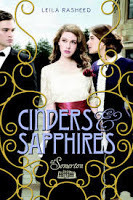
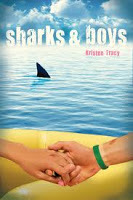
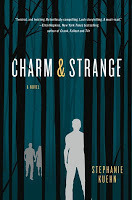
Cinders & Sapphires by Leila Rasheed: The intertwined lives of the prominent Averley family and the servants of Somerton Court are forever changed when an old secret comes to light.
Sharks & Boys by Kristen Tracy: Feeling betrayed, fifteen-year-old Enid follows her boyfriend, Wick, from Vermont to Maryland where he and six others they know from twin studies rent a yacht, but after she sneaks aboard a storm sets them adrift without food or water, fighting for survival.
Charm & Strange by Stephanie Kuehn: A lonely teenager exiled to a remote Vermont boarding school in the wake of a family tragedy must either surrender his sanity to the wild wolves inside his mind or learn that surviving means more than not dying.
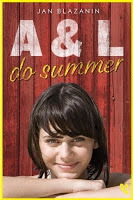
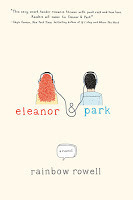
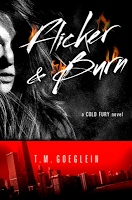
A & L Do Summer by Jan Blazanin: In Iowa farm country, sixteen-year-old Aspen and her friend Laurel plan to get noticed the summer before their senior year and are unwittingly aided by pig triplets, a skunk, a chicken, bullies, a rookie policeman, and potential boyfriends.
Eleanor & Park by Rainbow Rowell: Set over the course of one school year in 1986, this is the story of two star-crossed misfits--smart enough to know that first love almost never lasts, but brave and desperate enough to try".
Flicker & Burn by T M Goeglein (second book in the "Cold Fury" series): Sara Jane Rispoli continues searching for her missing mafia family, now running from mysterious creatures.
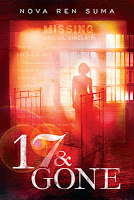
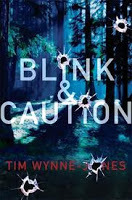
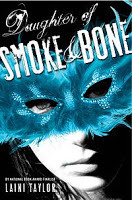
17 & Gone by Nova Ren Suma: Seventeen-year-old Lauren has visions of girls her own age who are gone without a trace, but while she tries to understand why they are speaking to her and whether she is next, Lauren has a brush with death and a shocking truth emerges, changing everything.
Blink & Caution by Tim Wynne-Jones: Two teenagers who are living on the streets and barely getting by become involved in a complicated criminal plot, and make an unexpected connection with each other.
The Daughter of Smoke & Bone by Laini Taylor (all three books in the series carry out the ampersand in the title): Seventeen-year-old Karou, a lovely, enigmatic art student in a Prague boarding school, carries a sketchbook of hideous, frightening monsters--the chimaerae who form the only family she has ever known.
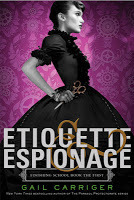
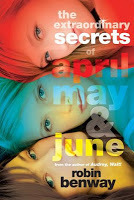
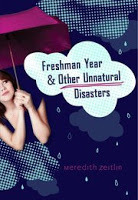
Etiquette & Espionage by Gail Carriger (all books in this series so far follow this pattern): In an alternate England of 1851, spirited fourteen-year-old Sophronia is enrolled in a finishing school where, she is suprised to learn, lessons include not only the fine arts of dance, dress, and etiquette, but also diversion, deceit, and espionage.
Extraordinary Secrets of April, May & June by Robin Benway: After their parents' divorce, teenaged sisters April, May, and June recover special powers from childhood and use them to cope with moving to a new home and high school, but wonder if the gifts have a greater purpose.
Freshman Year & Other Unnatural Disasters by Meredith Zeitlin: Smart, occasionally insecure, and ambitious Brooklyn fourteen-year-old Kelsey Finkelstein embarks on her freshman year of high school in Manhattan with the intention of "rebranding" herself, but unfortunately everything she tries to do is a total disaster.
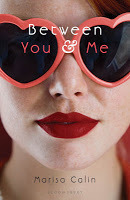
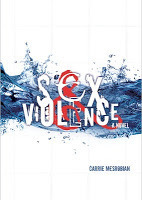
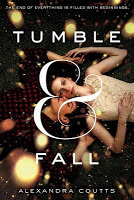
Between You & Me by Marisa Calin: Phyre, sixteen, narrates her life as if it were a film, capturing her crush on Mia, a student teacher of theater and film studies, as well as her fast friendship with a classmate referred to only as "you."
Sex & Violence by Carrie Mesrobian: Sex has always come without consequences for Evan. Until the night when all the consequences land at once, leaving him scarred inside and out.
Tumble & Fall by Alexandra Coutts: With an asteroid set to strike Earth in just one week, three teens on an island off the Atlantic Coast wrestle with love, friendship, family, and regret as they decide how to live their final days.
And coming in 2014 are at least two more books featuring the ampersand title:
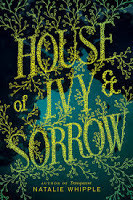
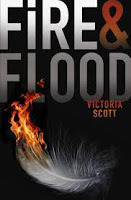
House of Ivy & Sorrow by Natalie Whipple: Seventeen-year-old Josephine Hemlock has spent her life hiding the fact that she's a witch--but when the mysterious Curse that killed her mother returns, she might not be able to keep her magical and normal lives separate.
Fire & Flood by Victoria Scott: Tella's brother Cody is sick and getting worse, so when she finds instructions on how to become a contender in the dangerous Brimstone Bleed race where she can win a cure for him, she jumps at the chance--but there is no guarantee that she will win, or even survive.






 Related StoriesHardcover to Paperback: Five Changes to Check OutHardcover to Paperback Switches: 6 to ConsiderPut a Bird on it: Cover Trend 2013
Related StoriesHardcover to Paperback: Five Changes to Check OutHardcover to Paperback Switches: 6 to ConsiderPut a Bird on it: Cover Trend 2013
Over the last few years, more and more YA titles have featured the ampersand. And while I love how it looks aesthetically, it's sometimes hard to search for book titles in a library catalog that feature an ampersand. The search operators can sometimes get caught up on it; often, though, a simple switch to a search by the author's name or using "and" in place of the ampersand can solve the problem.
Because I love ampersands and because I think it's become a trendy title punctuation in the last few years, here's a look at YA titles featuring them. All of these are books published between 2010 and now, with a couple of books that will be out in 2014. I'd love other traditionally published YA titles featuring ampersands, and I'm totally open to older titles. I've limited it to one book per series, as well as one book per author. Also excluded are short story anthologies -- a number of the ones out in the last year or two especially use ampersands.
All descriptions come from WorldCat.



Catch & Release by Blythe Woolston Eighteen-year-old Polly and impulsive, seventeen-year-old Odd survive a deadly outbreak of flesh-eating bacteria, but resulting wounds have destroyed their plans for the future and with little but their unlikely friendship and a shared affection for trout fishing, they set out on a road trip through the West.
Dash & Lily's Book of Dares by Rachel Cohn and David Levithan: Told in the alternating voices of Dash and Lily, two sixteen-year-olds carry on a wintry scavenger hunt at Christmas-time in New York, neither knowing quite what--or who--they will find.
Rot & Ruin by Jonathan Maberry (the entire series carries on the ampersand titling): In a post-apocalyptic world where fences and border patrols guard the few people left from the zombies that have overtaken civilization, fifteen-year-old Benny Imura is finally convinced that he must follow in his older brother's footsteps and become a bounty hunter.



Cinders & Sapphires by Leila Rasheed: The intertwined lives of the prominent Averley family and the servants of Somerton Court are forever changed when an old secret comes to light.
Sharks & Boys by Kristen Tracy: Feeling betrayed, fifteen-year-old Enid follows her boyfriend, Wick, from Vermont to Maryland where he and six others they know from twin studies rent a yacht, but after she sneaks aboard a storm sets them adrift without food or water, fighting for survival.
Charm & Strange by Stephanie Kuehn: A lonely teenager exiled to a remote Vermont boarding school in the wake of a family tragedy must either surrender his sanity to the wild wolves inside his mind or learn that surviving means more than not dying.



A & L Do Summer by Jan Blazanin: In Iowa farm country, sixteen-year-old Aspen and her friend Laurel plan to get noticed the summer before their senior year and are unwittingly aided by pig triplets, a skunk, a chicken, bullies, a rookie policeman, and potential boyfriends.
Eleanor & Park by Rainbow Rowell: Set over the course of one school year in 1986, this is the story of two star-crossed misfits--smart enough to know that first love almost never lasts, but brave and desperate enough to try".
Flicker & Burn by T M Goeglein (second book in the "Cold Fury" series): Sara Jane Rispoli continues searching for her missing mafia family, now running from mysterious creatures.



17 & Gone by Nova Ren Suma: Seventeen-year-old Lauren has visions of girls her own age who are gone without a trace, but while she tries to understand why they are speaking to her and whether she is next, Lauren has a brush with death and a shocking truth emerges, changing everything.
Blink & Caution by Tim Wynne-Jones: Two teenagers who are living on the streets and barely getting by become involved in a complicated criminal plot, and make an unexpected connection with each other.
The Daughter of Smoke & Bone by Laini Taylor (all three books in the series carry out the ampersand in the title): Seventeen-year-old Karou, a lovely, enigmatic art student in a Prague boarding school, carries a sketchbook of hideous, frightening monsters--the chimaerae who form the only family she has ever known.



Etiquette & Espionage by Gail Carriger (all books in this series so far follow this pattern): In an alternate England of 1851, spirited fourteen-year-old Sophronia is enrolled in a finishing school where, she is suprised to learn, lessons include not only the fine arts of dance, dress, and etiquette, but also diversion, deceit, and espionage.
Extraordinary Secrets of April, May & June by Robin Benway: After their parents' divorce, teenaged sisters April, May, and June recover special powers from childhood and use them to cope with moving to a new home and high school, but wonder if the gifts have a greater purpose.
Freshman Year & Other Unnatural Disasters by Meredith Zeitlin: Smart, occasionally insecure, and ambitious Brooklyn fourteen-year-old Kelsey Finkelstein embarks on her freshman year of high school in Manhattan with the intention of "rebranding" herself, but unfortunately everything she tries to do is a total disaster.



Between You & Me by Marisa Calin: Phyre, sixteen, narrates her life as if it were a film, capturing her crush on Mia, a student teacher of theater and film studies, as well as her fast friendship with a classmate referred to only as "you."
Sex & Violence by Carrie Mesrobian: Sex has always come without consequences for Evan. Until the night when all the consequences land at once, leaving him scarred inside and out.
Tumble & Fall by Alexandra Coutts: With an asteroid set to strike Earth in just one week, three teens on an island off the Atlantic Coast wrestle with love, friendship, family, and regret as they decide how to live their final days.
And coming in 2014 are at least two more books featuring the ampersand title:


House of Ivy & Sorrow by Natalie Whipple: Seventeen-year-old Josephine Hemlock has spent her life hiding the fact that she's a witch--but when the mysterious Curse that killed her mother returns, she might not be able to keep her magical and normal lives separate.
Fire & Flood by Victoria Scott: Tella's brother Cody is sick and getting worse, so when she finds instructions on how to become a contender in the dangerous Brimstone Bleed race where she can win a cure for him, she jumps at the chance--but there is no guarantee that she will win, or even survive.







 Related StoriesHardcover to Paperback: Five Changes to Check OutHardcover to Paperback Switches: 6 to ConsiderPut a Bird on it: Cover Trend 2013
Related StoriesHardcover to Paperback: Five Changes to Check OutHardcover to Paperback Switches: 6 to ConsiderPut a Bird on it: Cover Trend 2013
Published on August 18, 2013 22:00
August 17, 2013
"Inside the Industry" Guest Post and Quick Survey

Sara from the blog The Page Sage is running a really neat series she's calling "inside the industry," featuring interviews with people within the book world. She was kind enough to invite me to take part, and you can read my interview about librarianship, how to get into the field, the highs and lows of the job, and more over here.
This was a really fun interview to do, and I hope you enjoy reading it and learning a little bit more about on-the-ground librarianship.
***
Sara's series got me thinking about our own series posts at STACKED. I've been asked to do another contemporary week by more than one person, and I'd love to work something out again this fall to make that happen. But I'd love some input, if you're willing to give it -- so here is a short, four-question survey of what you'd like to see in a contemporary YA week series this fall. If you could help out that would be great, even if it's spreading the word to others who might be interested. (And to answer a question about my questions, I do mean 2014 and not 2013. I'd like to do a preview into the new year sort of post like I did for last year's contemp week -- that's not a typo).
And as a teaser, I'll say that Kimberly and I do have 2 other features planned for the fall -- our usual spotlight on horror in October, as well as a week-long series dedicated to reader's advisory which includes some really excellent guest posters (who I am so excited to hear from).
Loading...







 Related StoriesElsewhere in the book worldLinks of Note: August 3, 2013Links of Note: July 13, 2013
Related StoriesElsewhere in the book worldLinks of Note: August 3, 2013Links of Note: July 13, 2013
Published on August 17, 2013 08:32



